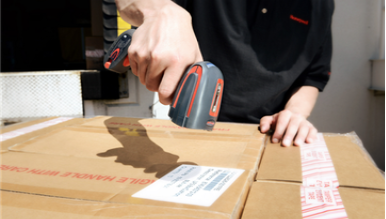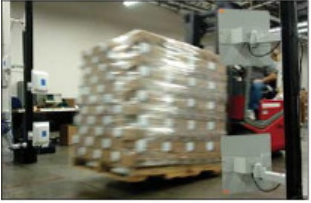Benefits of Automated Data Collection
By Wendy Stanley
The U.S. is currently enjoying strong economic growth. That’s great, right? Yes and no.
It’s true that an economy on the upswing is good for logistics and warehouse operations. Yet, many warehouses and distribution centers face challenges. The strong economy means higher transaction volumes and increased customer demands. This is especially true with the rise in online orders.
According to the U.S. Census Bureau, total e-commerce sales for 2018 increased 14.2% over 2017. With more e-commerce orders comes the expanding size and number of distribution hubs to stock and deliver goods. All this combined with a labor shortage signifies a need to cut inefficiency and spur cost savings wherever possible.
Technology to the rescue.
According to a 2018 study by Peerless Research Group, use of warehouse management systems (WMS) topped 90% for the first time. A WMS can automate manual business processes, resulting in critical savings in time and resources. But using a WMS to its full potential depends on the availability of accurate, real-time data.
For too many warehouses, manual data collection is still standard procedure. This puts real-time data out of reach. Manually managing warehouse processes is, without question, error-prone and inefficient. Maintaining spreadsheets and hand-keying data into a central computer wastes time and money.
Also, consider that the average human error rate for manually inputted data entry is 1%. That means every 1,000 characters typed averages 10 keying errors. How much of this flawed data is used to make key decisions?
It’s clear that the warehouse environment is full of opportunity to boost productivity. Even so, it may seem like streamlining warehouse management is an overwhelming task. This is precisely where automated data collection can help.
There are two methods used in warehouse management to automatically collect data: barcoding and radio frequency identification (RFID). Here’s a brief overview of each.
Barcoding
 Barcoding is the most common form of automated data collection. They’ve been used for decades to track everything from retail goods to machinery and medical records. In warehouses, barcode labels are applied to inventory and assets including containers, specialized tools, equipment and machines. Contained in each label is information about the item such as the item number or manufacturer.
Barcoding is the most common form of automated data collection. They’ve been used for decades to track everything from retail goods to machinery and medical records. In warehouses, barcode labels are applied to inventory and assets including containers, specialized tools, equipment and machines. Contained in each label is information about the item such as the item number or manufacturer.
There are pros and cons associated with the ubiquitous barcode. For example, barcodes are line-of-sight technology. This means a scanning device must scan each code individually. Also, barcode labels are attached to the outside of the product. This exposes the barcode to potential damage, which could affect its readability.
But there are definite advantages to barcoding. For instance, the cost of barcode labels is significantly lower in relation to RFID. Also, barcodes do not have limitations on the type of products they can be applied to.
RFID
In contrast, RFID takes automation to the next level. Unlike barcodes, RFID doesn’t require line of sight. This means RFID tags can be read at a faster rate than barcodes, without a human resource scanning each barcode label.
So how does RFID work? RFID is a technology that reads tags, identifies information about the object, and enters this information into a computer database. An RFID system uses an RFID tag, an RFID reader (also called an interrogator), and an antenna. The tag contains a circuit and an antenna, which transfers information to the reader.
Once the information is transferred, the reader converts the information to a more usable form of data. Then, specialized hardware transfers this information to a computer database.
Although this technology is similar to barcoding, RFID systems are able to store much more information than traditional barcodes. RFID tracks information such as product maintenance, shipping histories and expiration dates. However, RFID may struggle to read information when passing through liquid or metal. Also, a situation called reader collision can result. This happens when the signal from one reader interferes with the signal from another where coverage overlaps.
So which option is best for your warehouse? Choosing the right data collection method depends on many factors. These may include the type of items and your specific warehouse workflows. In fact, often a mix of barcoding and RFID solutions can achieve the desired result. In any case, an automated data capture system sets the stage for efficient warehouse management. It boosts efficiency from inventory and asset tracking to managing work orders.
Inventory & Asset Tracking
 Using automatic data capture for inventory management is faster than manual counting, recording and transferring. Also, when integrated to an ERP or backend system, it adds real-time visibility into quantities, location and status of your inventory and assets. In turn, it allows more accurate ordering, reducing waste, and preventing over- or under-purchasing. As a result, costs are reduced.
Using automatic data capture for inventory management is faster than manual counting, recording and transferring. Also, when integrated to an ERP or backend system, it adds real-time visibility into quantities, location and status of your inventory and assets. In turn, it allows more accurate ordering, reducing waste, and preventing over- or under-purchasing. As a result, costs are reduced.
Labor Productivity
Automated data collection can also ensure that your workers are operating at their highest productivity. Automating processes can optimize routine tasks. These warehouse tasks could include:
- Receiving and Put-Away
- Picking (Wave, Directed, Distributed)
- Cycle Counts
Consolidating these tasks helps workers complete replenishments, put-aways and picks simultaneously, and in a logical way. This is also called “task interleaving”. It eliminates non-productive activities, adding efficiency to warehouse processes.
Also, automated data collection can aide in collecting time metrics against jobs, tasks and work orders. This allows measurement and analysis of labor performance. As a result, accurate productivity reports are available to management.
LET’S GET STARTED
Automated data collection eliminates spreadsheets and manual tasks while reducing errors. As a result, your warehouse can gain visibility to inventory and assets, while ensuring your labor force operates as lean as possible. With automated processes in place, it also becomes easier to measure productivity and to make improvements when needed. If you’re seeking maximum efficiency, automated data collection can make your dream a reality.
Wendy Stanley is Marketing Director for Radley Corporation, a leading developer of productivity software. Since 1974, Radley Corporation has helped over 600 customers in 30 countries streamline workflows and automate processes. Radley’s configurable and scalable Manufacturing, Warehouse and EDI software solutions are aimed at improving efficiency and productivity for your business.
